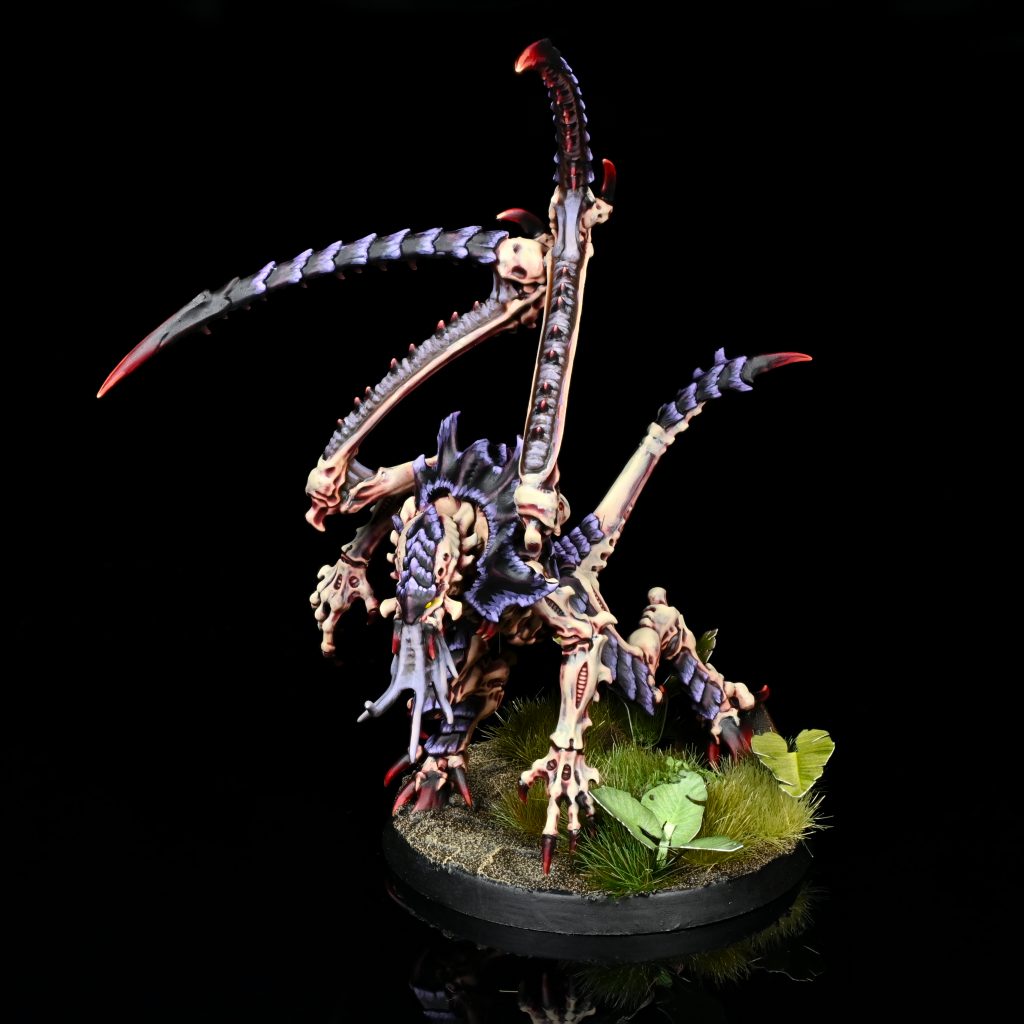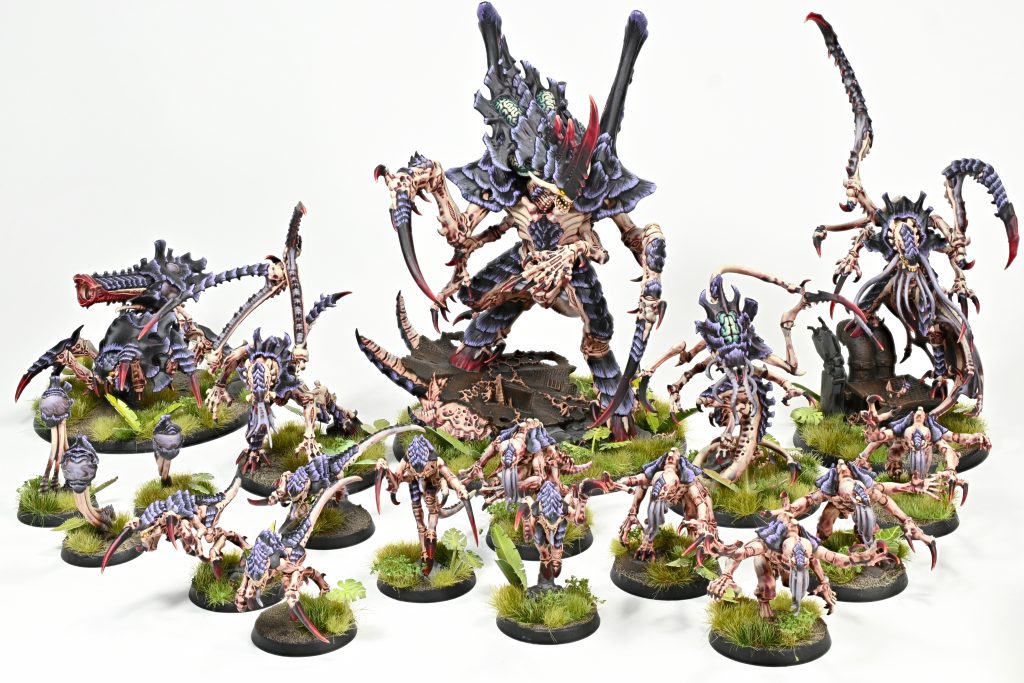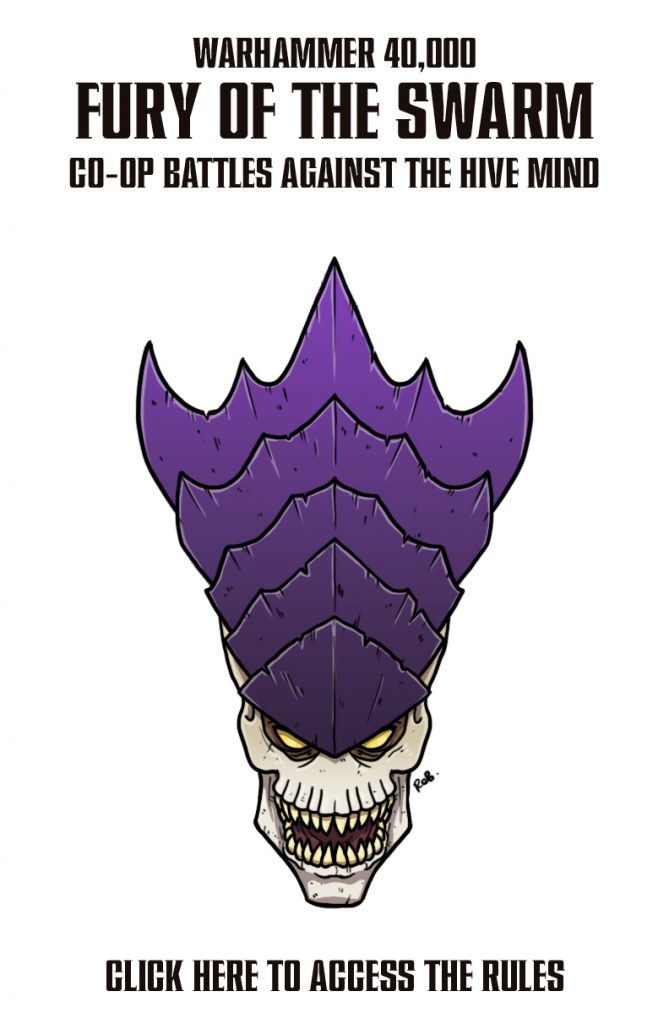Fury of the Swarm is an experimental co-op mode for Warhammer 40,000, in which the players face off against a swarm of Tyranids following instinctive protocols. Iterative versions have been released since June, all building up to this post: the release of Version One. Noice.
One feels a societal obligation to try and play things cool, but I’ve never been a particularly cool person. Let me therefore state: I’m a bit giddy. Gleeful, even. Teenage me would be bloody disgusted, but whatever. It’s alive. A whole load of people have played this thing and enjoyed it, which frankly is still a bit surreal, but they’ve also helped me shape it into a finished, playable co-operative supplement for Warhammer 40,000.
If you’re new to Swarm, know that you’ll need all the normal, official tools you’d need to play Warhammer 40,000, from the core rules to your codex/index. If you have no further interest in hearing about stuff behind the scenes, then click the big Tyranid head below and check out the rules, but please note: while they will display fine on a smartphone screen, they’ll look far nicer on a PC/tablet.
Fury of the Swarm route map
One post every fortnight
- Announcement post
- The initial release, with test mission
- Campaign mode go! Four missions in total, one for each campaign phase.
- Developer diary #1
- 2 new missions (Hold the Line & Resupply Run)
- 2 new missions (Repel Boarders & The Straggler)
- 2 new missions (Burn the Nest & Living Rain)
- Developer diary #2
- Developer diary #3
- The release of Version 1. <<<< YOU ARE HERE
Wait, I’m new to Fury of the Swarm. What is it?
It’s a full supplement for the household name-adjacent game Warhammer 40,000. Games Workshop have (quite understandably) preferred to keep their games focused on players facing off against each other, whereas this supplement enables you to team up with your mates to fight against automated Tyranids. The bugs use behavioural rules determined by the supplement, in a series of bespoke missions that are designed to link together into a campaign.

How do the Tyranids act, then?
Generally the Tyranids run straight towards the Player units most vulnerable to their weapons, using a pretty basic system called Preferred Prey. It works with any 40K faction, so you can defend your planet from the Hive Mind no matter which 40K faction you prefer.
Ten missions, lots of replayability
Some of the missions are pretty specific, but hopefully you’ll find they reward multiple outings, and that they all present a different challenge.
The other thing you should know about Swarm missions is that they are carrying about 50% of the gameplay load, meaning: the basic behavioural rules are only half the picture. Putting a bunch of the Tyranids’ behaviour into the missions themselves allowed me to vary the gameplay more than you might from regular games of 40K.
How do campaigns work?
I kept these pretty simple so that you don’t have much to track, but the narrative (and the missions) are directly affected by how well you do. There’s three phases to a Tyranid invasion. First up there’s Sporefall, where the Hive Fleet hurls itself against orbital facilities, anti-air emplacements, and so on. The Tyranids will eventually swamp these outer defences, so your objective is to make sure the defences cause as much carnage as possible before they fall silent. If you bleed the swarm white by winning a majority of the Sporefall missions you play, it’ll prevent a really spicy volume of reinforcements during the next phase of the campaign.
That next phase is the fulcrum, where the fate of your planet is decided. These are the most typical missions compared to regular 40K, with Retake and Hold being the most multipurpose mission. If you’re only going to play one game of Swarm, that’s the one to play.
If you win a majority of your Fulcrum missions, you finish the campaign with Extermination missions as you try to wipe out the remaining xenos. Alternatively, if the Fulcrum didn’t go your way, it’s time to spit out a few teeth and limp your way through the Evacuation missions.

For experienced Swarm playtesters: what’s new to Version One?
Experienced Fury of the Swarm players might like to know what’s changed between the last test build (v0.6) and Version 1. As ever, I’ve recorded those in the rules’ changelog, but for convenience:
- To help out those units whose abilities trigger on proximity to objectives, I’ve clarified that certain units or objects count as objectives in three missions (Resupply Run, The Last Shuttle, and The Straggler). That means 8/10 missions offer some objective-based interactions.
- The +1 to hit bonus for Tyranids in Synapse range has been made into an optional rule for players who want a beefier challenge. For me this is the default way to play, but I have to recognise that while I’m no tournament player, I’ve been playing this game since the 90s. A newer player might need a gentler introduction!
- There are also minor edits throughout.
- Finally, in addition to a facelift, the supplement finally has a cover. This somehow makes it feel much more like a finished thing to me. Here is said cover:

I didn’t have the time or skill to produce a cover illustration of GW’s artistry, so this is the closest I could get. Technically speaking, it’s a heavily rotoscoped composite photograph. That basically means I took several black and white photos, laid them over each other in Photoshop, and then painted over the top so I didn’t have to map where everything goes. For an inexperienced painter like me, this really speeds things up. It still took many hours of work, but not a patch on the time it takes to do a more crisp cover illustration like a pro. It also helps that Photoshop lets me have lots of transparent layers, so for example I can just paint the carapace sections red, then when I painted the yellow and blue light over the top, the colours mix properly. A trained painter can do that kind of thing by eye.
Are there future plans for Fury of the Swarm?
Yes, albeit loose ones. I’m going to take a break for at least a few months, but will still respond to feedback messages, and patch the rules if needed (although no major changes have been required for over a month at this point, so hopefully it’ll be fine? …sure buddy, famous last words).
If we were releasing a sellable product we’d be able to judge its success by sales, but we aren’t. This means the decision to undertake the work needed to expand this game mode further relies on you, the player, letting us know you want it. If there’s the interest, my intention is to expand this out to 40K’s next most horde-tacular faction: the orks. You might be wondering why I don’t write a catch-all supplement that covers all races; it’s because I think the quality of gameplay is greatly enhanced by having missions and behavioural rules written specifically around each faction. Naturally, the rules would share the bones of the work that’s already been done, but I want each race to feel like they’re trying to wreck your face in their own special way.
In terms of plans involving the wider Goonhammer crew, Rob (our content-director-in-chief) has been talking about how cool it would be to publish a proper PDF of this first edition, and obviously that would be cool as hell. Indeed, I almost did just that for this release, but ultimately Google Docs’ ability to switch its formatting automatically for smartphone users was too good a usability upgrade to ignore. But it did mean sacrificing that sweet, sweet visual fidelity.
There’s also talk of maybe adding functionality to Administratum and the Tabletop Battles App to enable people to run Swarm events, so speak up if that’s something you’d be stoked for. Having an event in which we have multiple teams simultaneously trying to fend off a Hive Fleet would be undeniably juicy, and having that digital infrastructure in place would only make it that much easier for someone to run it.
That would, of course, require people bringing a lot of painted Tyranids. Myself and some friends are planning to paint up some as a communal effort for our gaming group, since right now we’ve “just” got Tom’s 2,500 point army, and that means only one active table at a time for beefy games. We need more. MOOOORE.

Final thoughts
This project has been so much fun. I was worried I’d burn out on it, and while I’m extremely pleased to be getting so much free time back, I never stopped enjoying the development process, and I have alllll the orks I could possibly need to make the next one. I’m very grateful to Rob for saying yes to the initial pitch back in April. I’m also incredibly grateful to all the playtesters who wrote in with their experiences. Seeing photos of people playing the thing I wrote is great, hearing about the games is great, getting actionable feedback… also great.
If, like me, you’ve ever fancied painting a swarm of Tyranids but didn’t actually want to play as them yourself, hopefully this gives you a reason to pick up your brush and start.

Feedback
If you’d like to send feedback or questions about Swarm, the most helpful way is probably the battle feedback form. You’re also very welcome to get in touch by emailing contact@goonhammer.com or by reaching out to me (Charlie) on Instagram. If you’re a Goonhammer patron, you can also @Charlie B on the Discord server.




You must be logged in to post a comment.